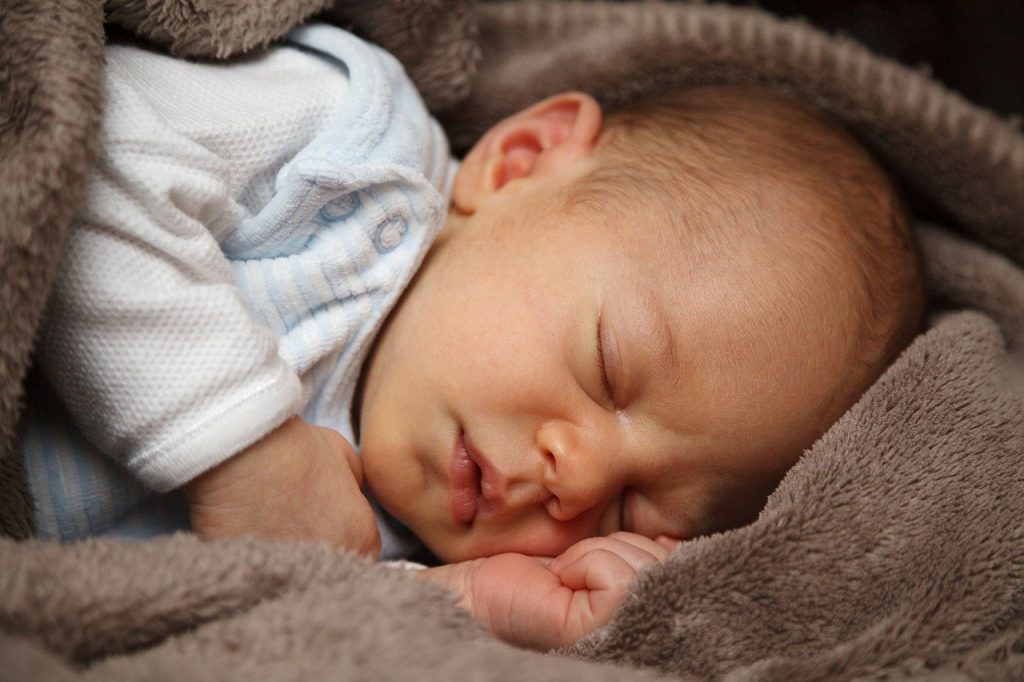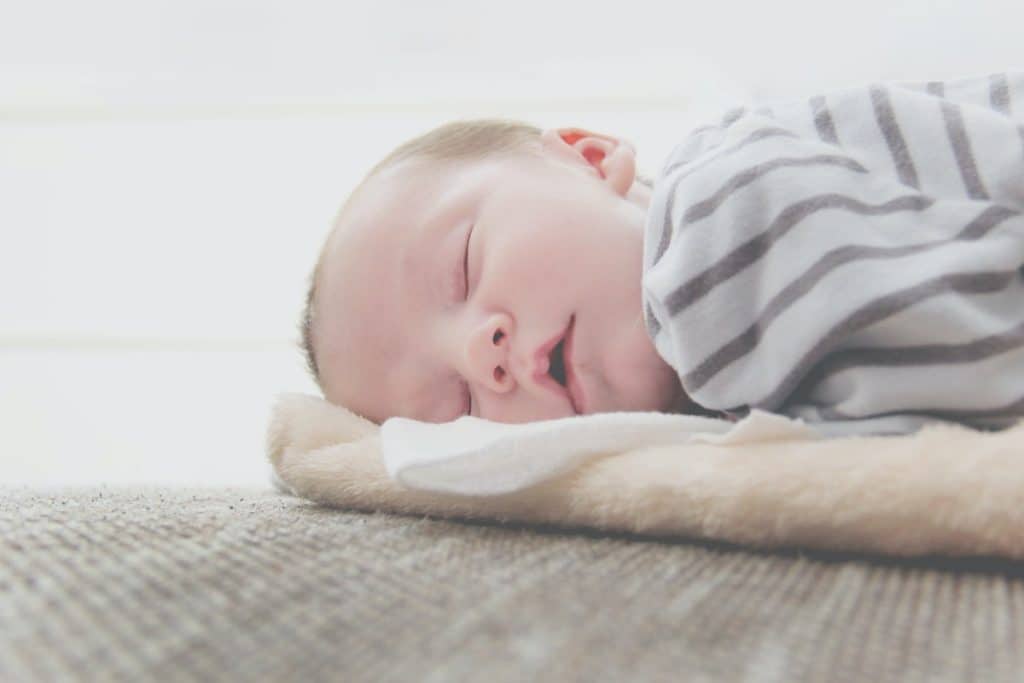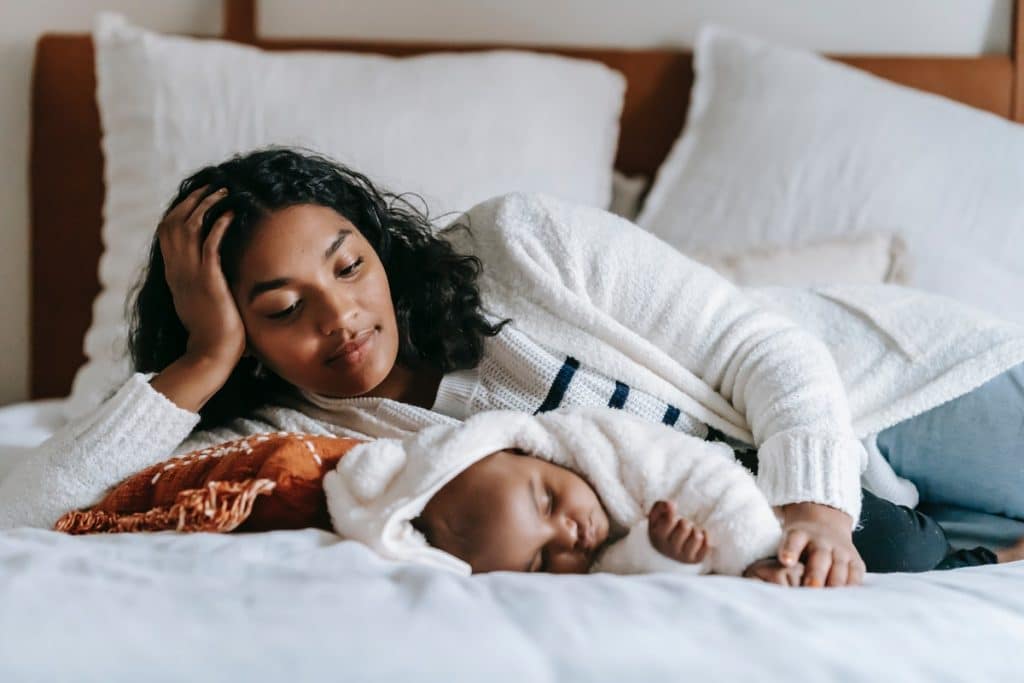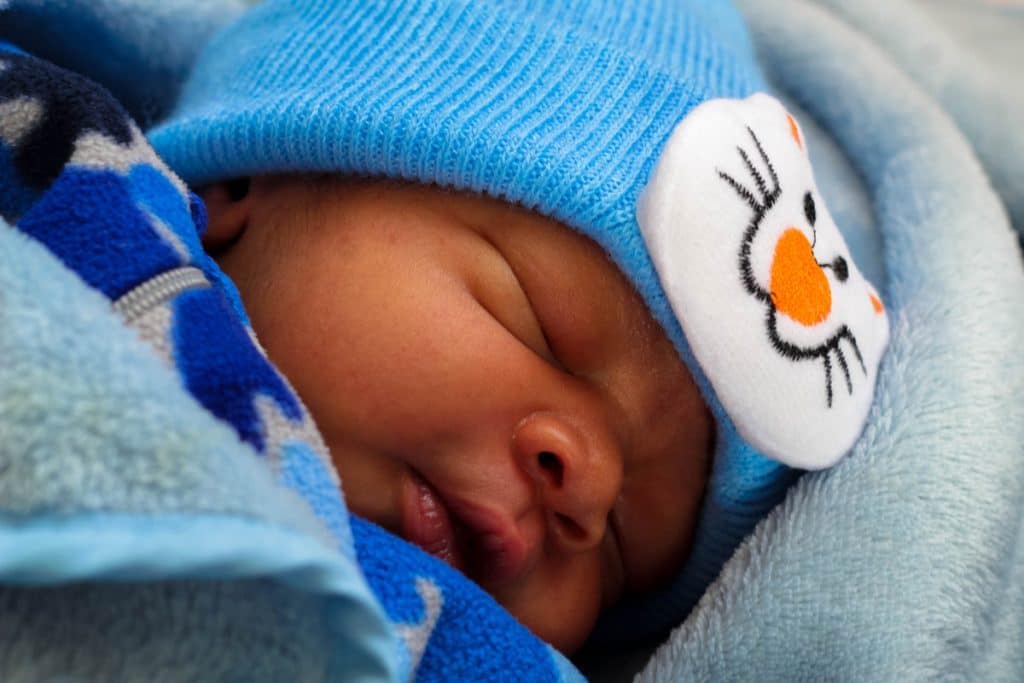Babies need to be kept warm at night but they don’t produce their body heat. This can lead to a variety of problems, from sudden infant death syndrome (SIDS) risk to respiratory infections. For the baby to stay warm and minimize the risk of these health issues, parents should use one or more of the following techniques: swaddle lightly with a blanket; use an infant sleep sack with footsies; invest in a high-quality crib mattress pad; and place baby on his or her back (never on their stomach).
A baby’s ability to regulate his body temperature is not fully developed at birth. Keeping baby warm at night, minimizing sudden infant death syndrome (SIDS) risk, and using a sound sleep routine is key in keeping your child healthy and happy. There are many ways you can keep your baby warm during the cold winter months without putting them in an excessive amount of layers or leaving them exposed to other dangers.

In This Article
9 Tips to Keep Your Baby Warm at Night
For moms during winter, keeping babies warm can be a challenge. When it’s cold outside, it becomes difficult for babies to regulate their body temperature and they are more vulnerable to coughs, flu, and colds.
Parents often want to know how to keep their babies warm at night, but many confusing rules are surrounding what they should wear while sleeping.
This blog post will help you determine how to keep your baby warm at night. Along with this, we’ll introduce the point in time when can baby sleep with blankets or other coverings that are no longer necessary for your infant.
Tip #01: Use a lightweight blanket or sleep sack to swaddle your baby. A light cotton blanket is best for warmth. Put the top part of the blanket under the baby’s chin and tuck it around their delicate neck area as tightly as possible without choking them. If you are using an infant sleep bag, don’t worry about this step.
Tip #02: Use a high-quality mattress pad in your baby’s crib to minimize sudden infant death syndrome (SIDS) risk. Many parents are surprised that this is so important, but it helps keep the surface of the mattress from sagging and provides extra padding for babies as they transition out of swaddling into their more grown-up sleep sacks or blankets.
Tip #03: Place baby on their back (never on their stomach). This is to minimize the risk of SIDS. It’s also important for your infant not to sleep in an excessive number of layers or with other heavy bedding items that could cause suffocation, plus many parents worry it will keep them too hot and uncomfortable all night long.
Tip #04: Buy a sound machine for the baby’s room to minimize disruptions and provide soothing noises or sounds that they enjoy hearing. This is helpful when you want some peace from the outside world to better rest next to your little one who just won’t stop crying. A white noise generator may be used, but it should only be used when the baby is in the room.
Tip #05: Use a sleep sack with footsies, if needed. This will keep your infant’s feet warm and make them more comfortable (and it can also help to avoid the risk of SIDS). If you are using an infant sleep bag without these features, don’t worry about this step either.
Tip #06: Make sure the baby’s room is properly ventilated. This will help to minimize the risk of SIDS and keep your infant from sleeping in a stuffy, too warm environment that can cause respiratory infections or other health problems if they are unable to breathe comfortably during their sleep.
Tip #07: Keep baby blankets washed and clean. Wash bedding items weekly and use a baby mattress pad to minimize the risk of SIDS in between washings. This will help ensure your infant is not sleeping on the same sheets they drooled or spit up on the night before, and it can also reduce respiratory issues that come with sharing dirty sheets at night.
Tip #08: Use a pacifier to help babies sleep or soothe themselves. This is an important part of a good night’s rest for your infant, and it also reduces the risk of SIDS because it helps with calming them down and reducing their anxiety levels when they are sleeping in unfamiliar surroundings.
Tip #09: Use soft bedding items that are appropriate for the baby’s age. If your infant is a newborn, you may want to lean towards plain blankets and sheets that are appropriate for their size so they don’t suffocate or become too hot during the night. You can also use footies on an older baby’s feet with soft fabric instead of cotton if necessary.

How to Keep Your Baby Safe From SIDS?
Sudden Infant Death Syndrome (SIDS) is a term for the unexplained death of an infant. SIDS can happen in any number of ways, including suffocation from soft bedding or objects like pillows and blankets; entrapment between crib rails or other furniture; and strangulation on cords from window blinds, among many others.
Most babies can’t roll over until they’re at least 3 months old, so one way to reduce your baby’s risk is by keeping them on their back when they sleep. You should also avoid using too much loose bedding as well as keep your baby away from smoke and alcohol while she sleeps. Check out these tips to learn more about how you can keep your baby safe!
SIDS is the sudden death of an infant less than 1-year-old, which remains unexplained even after a complete autopsy and thorough investigation. One in every 2,000 babies will die from SIDS each year.
1. Place your baby on his or her back to sleep –
Babies are much more at risk of SIDS when they sleep on their side or stomach. These positions can cause them to roll onto their stomach and suffocate in the mattress.
Parents can help babies avoid SIDS by making sure fall asleep on their backs and not on their stomachs or sides. When a baby is on its side, it can roll onto its stomach which is the biggest risk factor for SIDS.
Some parents are afraid that their children will choke on vomit if they are put on their back. But studies don’t show this happening.
Your baby can develop a flat spot on the back of his head. He might sleep on his back and that can make it happen.
To protect your baby from SIDS and to strengthen their muscles, they need to be on their stomach several times a day. Experts recommend supervised tummy time while your child is awake.

2. Put your baby in a place that is firm –
An unsafe sleep surface is one of the most common preventable causes of SIDS. An asleep surface that is not firm enough can lead to suffocation.
Parents should avoid using baby slings and instead choose a crib or bassinet, which are safer sleep environments for infants.
The best sleep surfaces for babies include:
- A firm sleep surface such as a crib, bassinet, or play yard.
- Sleep surface covered by a fitted sheet that fits tightly all the way around with no other layers underneath.
3. Keep soft objects out of your baby’s sleep area –
Make sure there are no pillows or loose blankets in your baby’s sleep area or sleep environment. Toys, stuffed animals, and other objects can easily lead to suffocation if they are placed in your baby’s sleep area or sleep environment while he is sleeping. Some babies have died when their parents fell asleep with them on their chests. Other babies might roll over and get caught in the pillow or blanket.
4. Make sure cribs meet safety standards –
Parents should make sure that cribs meet safety standards. Parents should put all babies to sleep on their backs. Babies may sleep in the same room as their parents for at least the first six months, but they should sleep in a separate sleep area or bassinet equipped with a firm mattress covered by a tight-fitting sheet.
5. Keep your Baby sleep area tidy –
Avoid loose bedding when you sleep, which can increase the risk of SIDS and suffocation. You should also avoid placing heavy objects near your baby’s sleep area. If you are holding your baby while sleeping, you should sleep in a separate sleep area to avoid suffocation.
6. Make sure your baby sleeps on a firm mattress –
It is important to keep your baby safe from SIDS when they sleep. Safe sleep includes:
-Your baby should be sleeping on a firm mattress, covered only with a tight sheet. They cannot sleep under fluffy blankets or pillows and are not allowed to nap on an inflatable bed or sofa.
-Babies should sleep on their back on a firm mattress and sleep surface.
-Do not fall asleep with your baby on a couch, chair, or water surface like a bathtub. Babies can suffocate when they sleep face down and their nose and mouth are covered by something such as the side of a couch, a pillow, or a blanket.
7. Don’t Share your Bed But Keep Sleeping Baby Close –
The risk of SIDS is lowered when a baby sleeps in the same room as a mom. it is also risky for a baby to sleep with others or on an armchair, couch, or bed.
If you bring your baby into your bed for breastfeeding or comforting, make sure to put the baby back in their cradle, bassinet, or crib when ready. If tired, don’t breastfeed while sitting on a chair or couch as this may cause you to fall asleep and potentially harm the baby.
You sleep better with your baby in the bed. Babies sleep safer in their cribs or bassinets, but you sleep better if you sleep close to your baby. Remember:
To prevent SIDS, always place babies on their backs- not on their tummy – for sleep and naps.
The American Academy of Pediatrics recommends placing infants on the back to sleep for every sleep time. This is because babies have a higher risk of SIDS if they sleep face-down compared with babies who sleep on their back or side. It’s also best not to place your baby to sleep using any type of sleep positioner, which may present an additional risk of SIDS and sleep-related breathing disorders.

8. Breastfeed your baby as much as you can –
Breastfeeding your baby from birth to six months can lower the risk of SIDS by as much as 50%. Though experts aren’t sure why breastfeeding lowers the risk, some believe breast milk may reduce babies’ risk of infections which raises their risk of SIDS.
When your baby is born, breastfeeding protects him from SIDS. Babies sleep best when they are close to you at the beginning of sleep and during sleep. You may sleep better if you breastfeed or snuggle with your baby in a rocking chair or bedside crib before tucking them into their sleep area or bed.
9. Don’t smoke near your baby –
Never smoke at home or in a car when your baby is there. Smoke can stick to and re-enter the house, even with windows open. Secondhand smoke contains many chemicals that are harmful to you and your baby. It raises the risk of SIDS for babies who sleep in the same room where someone smokes and makes an infant’s sleep environment more dangerous. Babies sleep best when they sleep through the night in their sleep area or bed. Always make sure you’re not a sleep-deprived smoker who smokes to relieve stress – if this is you, talk to your doctor about counseling and stop smoking for the sake of your baby’s health!
Some parents think that caffeine and sleep deprivation help them sleep better and longer, this is not the case – sleep-deprived parents who drink coffee to stay awake may sleep only two hours less than if they didn’t. It would be better for your baby if you spent time bonding with him instead of drinking coffee or any other sleep-inducing beverage!
10. Check for baby’s safety at night by doing a regular check-up –
Breastfeeding and bed-sharing are not the only ways to keep your infant safe from SIDS. You can also make sure you always have them sleep on their back, as well as use soft sheets and blankets that are appropriate for the baby’s age. It is also important to sleep near your baby so you can regularly check and make sure they are safe at night –
If there have been any changes in sleep patterns, behavior, or eating habits, it may be a sign of SIDS risk- factors such as smoking with an infant while sleeping could lead to SIDS.

What is the difference between SIDS and SUID?
SIDS: Sudden Infant Death Syndrome is the sudden and unexplained death of an infant who appears healthy in all respects with no previous indications of distress. Full data concerning the actual causes of SIDS remain unavailable for classification, though many hypotheses have been proposed. The most likely explanations relate to abnormalities in breathing, heart rate, seizures, or other factors associated with life support mechanisms.
SUID: Sudden Unexplained Infant Death just like its sibling acronym “SIDS”. It seems that we know everything about SIDS except the main reason why it happens or how to prevent it from happening again–even though every sad case has more than a hundred unanswered questions and potential contributing variables. SIDS is a sleep-related death in an infant younger than 1-year-old which remains unexplained after a complete investigation. SIDS and other sleep-related deaths are known collectively as sudden unexpected infant death (SUID). Also included in SUID are sleep-related deaths of unknown causes, ill-defined and unspecified causes.
Many factors can lead to sleep related infant deaths. For example, sleeping in the supine position (facing up), exposure to unsafe sleep surfaces and bedding, respiratory infections, obstructive airway disorders such as cystic fibrosis, small for gestational age babies which are also likely to be on their backs in the supine position can all lead to death.
The sleep stages that have been associated with sleep-related infant deaths are the deepest sleep phases which include slow-wave sleep, and deep sleep (delta sleep). Also, SIDS may be linked to problems in arousal from sleep. In other words, babies do not wake up to danger or turn their bodies so they don’t suffocate when in a sleep position that can cause sleep related infants deaths.

What environments are unsafe for sleeping babies?
A baby should never sleep in an environment that can be smoky, offer an inadequate room as too small, have inadequate safety features such as not being securely mounted to the wall or without stairs with firm and stable steps on both sides. A bed also should only be used for one person at a time, and babies always need supervision when they are in bed.
A safe infant sleeping environment requires proper ventilation which is why consistent airflow throughout the night is important. There should not be any objects near baby including curtains, other people’s mattresses, or pets because babies might breathe the fumes that emit from them or roll into things and become constricted while they’re sleeping.
The American Academy of Pediatrics recommends that you have your baby sleep in any position they find comfortable, whether it is on their back, front, or side. They also recommend that parents place soft bedding such as blankets and sleeping bags under the crib sheet to prevent babies from suffocating themselves if they start to turn onto their stomachs.
Conclusion
This blog post has provided you with a number of resources that will help keep your baby warm at night and minimize the risk for SIDS. You should now have all of the information necessary to make an informed decision about how best to care for your infant’s comfort level, so don’t hesitate to investigate these helpful options further! Your pediatrician should also have suggestions about how best to keep your little one safe and comfortable when they need help generating warmth during sleep time.











